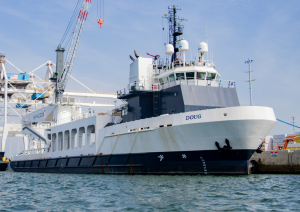Ms. Tree
SpaceX

Ms. Tree catches a fairing half – SpaceX
Ms. Tree (Previously named Mr. Steven) is a fast, highly maneuverable vessel that was chartered by SpaceX from 2017 until 2021 in support of the fairing recovery program. The ship was configured with a large net to catch payload fairings. As of April 2021, SpaceX is no longer attempting to catch payload fairings and Ms. Tree has been retired from SpaceX operations and operates elsewhere in the maritime industry. The name ‘Ms. Tree’ is a pun of the word ‘Mystery’.
Ms. Tree was originally built as a fast crew/supply vessel, serving the oil industry in the Gulf of Mexico. In late 2017, the vessel was chartered by SpaceX as they continued the development of the fairing recovery program. Ms. Tree was assigned to Pacific Ocean operations and based at the Port of Los Angeles, California.

Ms. Tree’s mission debut with original net – SpaceX
Catch Time

Installation of new arms and net – Pauline Acalin
Ms. Tree, with her new net, persevered throughout the rest of 2018 but was unable to catch a fairing half during a mission. SpaceX conducted numerous drop tests in an attempt to fine-tune the process. During these tests, a helicopter would lift a fairing to 10,00ft before dropping it for Ms. Tree to chase. These tests were reportedly not successful either.
With a lack of upcoming missions launching over the Pacific Ocean after 2018, SpaceX decided to move Ms. Tree to the Atlantic Ocean. The ship made the move in February 2019 and began operating out of Port Canaveral, Florida.
Ms. Tree’s first encounter with the Atlantic Ocean proved to be treacherous. Whilst traveling offshore for the PSN-6 mission, Ms. Tree encountered some very bad weather where waves managed tear off two of the four arms that held up the net. The catch attempt was abandoned and the ship returned to Port Canaveral for repairs.

The remains of Ms. Tree’s arm structure being removed after the PSN-6 mission – Ken Kremer
Recovery Success
First Successful Catch: Ms. Tree’s first successful catch was on June 25th, 2019, during the STP-2 mission. This was Ms. Tree’s seventh attempt. The offshore weather was noted as being optimal and the catch attempt happened a record 1350 km downrange from the launchpad.
Ms. Tree was again successful during the AMOS-17 mission on August 7th, 2019. The program later saw further success, but not consistently. SpaceX chartered a second fairing catcher vessel, Ms. Chief, in August 2019 to allow them to catch both fairing halves during a single mission.
Ms. Tree made seven confirmed successful catches during its period with SpaceX.
Inconsistency and Retirement
Throughout 2020, SpaceX was not always attempting to catch the fairing half and instead opting to go straight for wet recovery, a process where the fairing is allowed to gracefully land on the ocean surface and is then lifted onto the recovery ship. This method often proved more reliable and less high-risk than catch attempts – which occasionally ended with significant damage to fairings and the catcher ships.
With a lack of catching reliability, SpaceX decided to abandon the catching program and opted to conduct wet recovery by default. Megan and Shannon took on the responsibility of fairing recovery in March 2021 and Ms. Tree and Ms. Chief were slowly de-rigged of all SpaceX equipment – a process that itself took well over a month to complete. SpaceX made significant upgrades to both ships, including the catching structure, computer systems, communications, and rigging
A new fairing recovery ship, Shelia Bordelon, was contracted in March 2021 to take on the sole responsibility of fairing recovery for an interim period before the program reached its current evolution with dual-purpose support vessels Bob and Doug.
Ms. Tree was officially retired from SpaceX recovery operations on April 6th, 2021. The crew of the vessel conducted a ceremonial water salute to spectators as they departed Port Canaveral for the very last time.

Ms. Tree retires from SpaceX operations with a ceremonial water salute – NASASpaceflight
Vital Statistics
Owner: SEACOR Marine
Year Built: 2014
IMO: 9744465
Length: 62.5m / 205 ft
Breadth: 10.4m / 34 ft
Joined SpaceX Fleet: 2017
Retired from SpaceX Fleet: 2021
Similar SpaceX Ships
Fast, maneuverable vessel that was previously modified to catch fairing halves. Retired in 2021. Read more…
 Dual-purpose support vessel based in Florida for fairing recovery and droneship support. Read more…
Dual-purpose support vessel based in Florida for fairing recovery and droneship support. Read more…
 Dual-purpose support vessel based in Florida for fairing recovery and droneship support. Read more…
Dual-purpose support vessel based in Florida for fairing recovery and droneship support. Read more…

